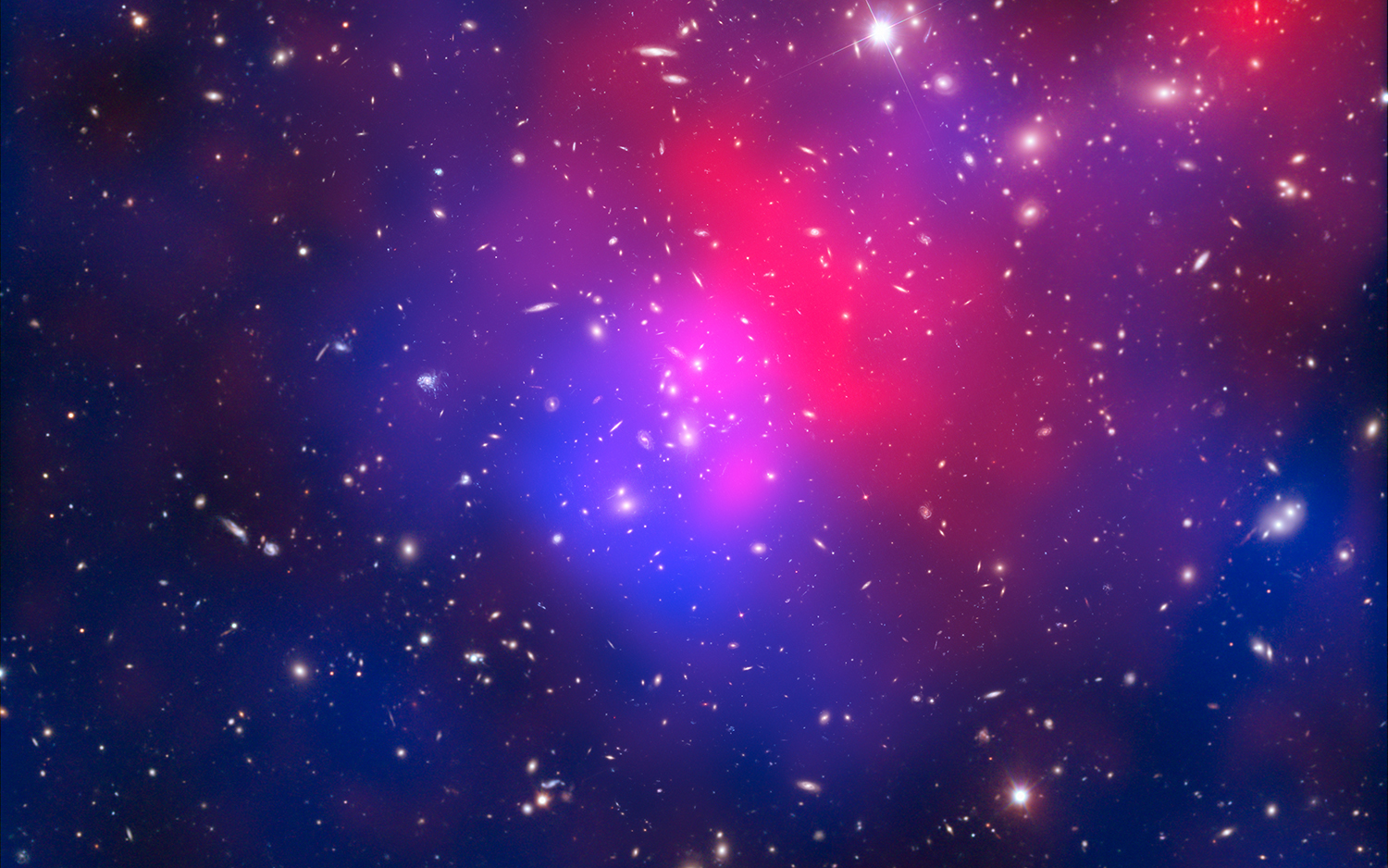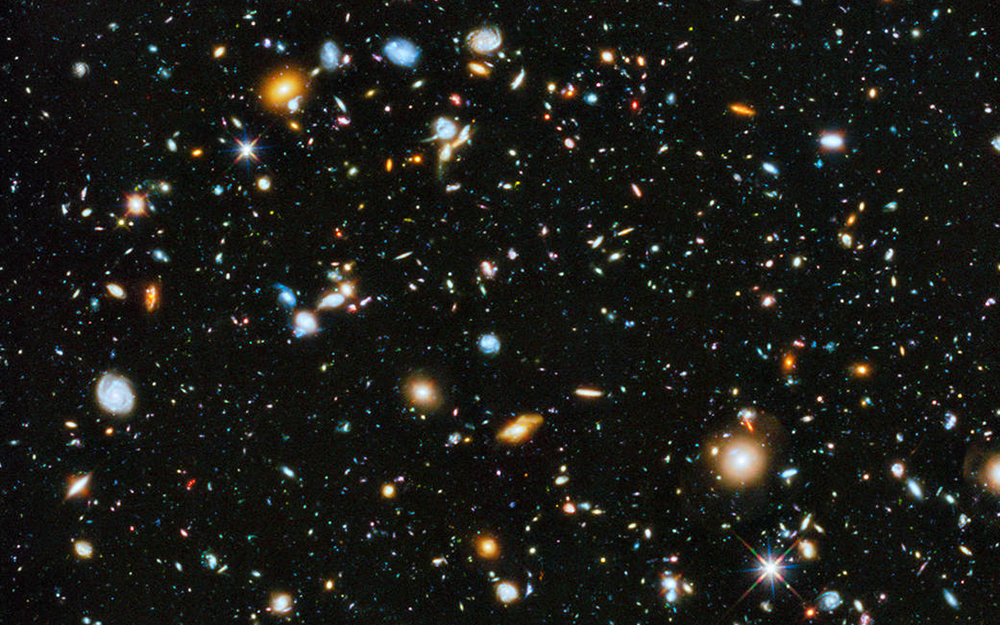What Is the Universe Made of?
Where did everything in the universe come from?

The universe is filled with billions of galaxies and trillions of stars, along with nearly uncountable numbers of planets, moons, asteroids, comets and clouds of dust and gas – all swirling in the vastness of space.
But if we zoom in, what are the building blocks of these celestial bodies, and where did they come from?
Hydrogen is the most common element found in the universe, followed by helium; together, they make up nearly all ordinary matter. But this accounts for only a tiny slice of the universe — about 5%. All the rest is made of stuff that can't be seen and can only be detected indirectly. [From Big Bang to Present: Snapshots of Our Universe Through Time]
Mostly hydrogen
It all started with a Big Bang, about 13.8 billion years ago, when ultra-hot and densely packed matter suddenly and rapidly expanded in all directions at once. Milliseconds later, the newborn universe was a heaving mass of neutrons, protons, electrons, photons and other subatomic particles, roiling at about 100 billion degrees Kelvin, according to NASA.
Every bit of matter that makes up all the known elements in the periodic table — and every object in the universe, from black holes to massive stars to specks of space dust — was created during the Big Bang, said Neta Bahcall, a professor of astronomy in the Department of Astrophysical Sciences at Princeton University in New Jersey.
"We don't even know the laws of physics that would have existed in such a hot, dense environment," Bahcall told Live Science.
About 100 seconds after the Big Bang, the temperature dropped to a still-seething 1 billion degrees Kelvin. By roughly 380,000 years later, the universe had cooled enough for protons and neutrons to come together and form lithium, helium and the hydrogen isotope deuterium, while free electrons were trapped to form neutral atoms.
Get the world’s most fascinating discoveries delivered straight to your inbox.
Because there were so many protons zipping around in the early universe, hydrogen — the lightest element, with just one proton and one neutron — became the most abundant element, making up nearly 95% percent of the universe's atoms. Close to 5% of the universe's atoms are helium, according to NASA. Then, about 200 million years after the Big Bang, the first stars formed and produced the rest of the elements, which make up a fraction of the remaining 1% of all ordinary matter in the universe.
Unseen particles
Something else was created during the Big Bang: dark matter. "But we can't say what form it took, because we haven't detected those particles," Bahcall told Live Science.
Dark matter can't be observed directly — yet — but its fingerprints are preserved in the universe's first light, or the cosmic microwave background radiation (CMB), as tiny fluctuations in radiation, Bahcall said. Scientists first proposed the existence of dark matter in the 1930s, theorizing that dark matter's unseen pull must be what held together fast-moving galaxy clusters. Decades later, in the 1970s, American astronomer Vera Rubin found more indirect evidence of dark matter in the faster-than-expected rotation rates of stars.
Based on Rubin's findings, astrophysicists calculated that dark matter — even though it couldn't be seen or measured — must make up a significant portion of the universe. But about 20 years ago, scientists discovered that the universe held something even stranger than dark matter; dark energy, which is thought to be significantly more abundant than either matter or dark matter. [Gallery: Dark Matter Throughout the Universe]

An irresistible force
The discovery of dark energy came about because scientists wondered if there was enough dark matter in the universe to cause expansion to sputter out or reverse direction, causing the universe to collapse inward on itself.
Lo and behold, when a team of researchers investigated this in the late 1990s, they found that not only was the universe not collapsing in on itself, it was expanding outward at an ever faster rate. The group determined that an unknown force — dubbed dark energy — was pushing against the universe in the apparent void of space and accelerating its momentum; the scientists' findings earned physicists Adam Riess, Brian Schmidt and Saul Perlmutter the Nobel Prize in Physics in 2011.
Models of the force required to explain the universe's accelerating expansion rate suggest that dark energy must make up between 70% and 75% of the universe. Dark matter, meanwhile, accounts for about 20% to 25%, while so-called ordinary matter — the stuff we can actually see — is estimated to make up less than 5% of the universe, Bahcall said.
Considering that dark energy makes up about three-quarters of the universe, understanding it is arguably the biggest challenge facing scientists today, astrophysicist Mario Livio, then with the Space Telescope Science Institute at Johns Hopkins University in Baltimore, Maryland, told Live Science sister site Space.com in 2018.
"While dark energy has not played a huge role in the evolution of the universe in the past, it will play the dominant role in the evolution in the future," Livio said. "The fate of the universe depends on the nature of dark energy."
- Beyond Higgs: 5 Elusive Particles That May Lurk in the Universe
- 11 Fascinating Facts About Our Milky Way Galaxy
- The 11 Biggest Unanswered Questions About Dark Matter
Originally published on Live Science.

Mindy Weisberger is a science journalist and author of "Rise of the Zombie Bugs: The Surprising Science of Parasitic Mind-Control" (Hopkins Press). She formerly edited for Scholastic and was a channel editor and senior writer for Live Science. She has reported on general science, covering climate change, paleontology, biology and space. Mindy studied film at Columbia University; prior to LS, she produced, wrote and directed media for the American Museum of Natural History in NYC. Her videos about dinosaurs, astrophysics, biodiversity and evolution appear in museums and science centers worldwide, earning awards such as the CINE Golden Eagle and the Communicator Award of Excellence. Her writing has also appeared in Scientific American, The Washington Post, How It Works Magazine and CNN.


